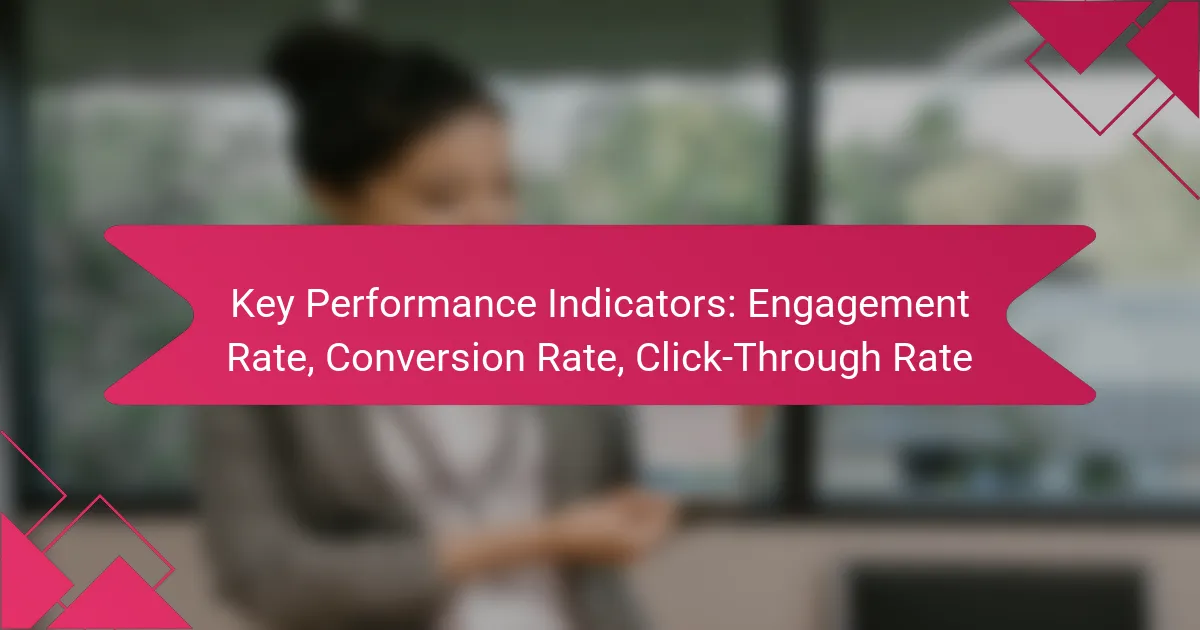Key Performance Indicators (KPIs) such as engagement rate, conversion rate, and click-through rate are essential metrics for assessing the effectiveness of digital marketing strategies. By understanding and optimizing these indicators, businesses can enhance audience interaction, improve user experience, and drive desired actions, ultimately leading to better overall performance. Implementing targeted tactics and continuously analyzing results will help refine approaches for maximum impact.

How to improve engagement rate in digital marketing?
Improving engagement rate in digital marketing involves creating content that resonates with your audience and encourages interaction. Focus on delivering value through various channels, while continuously analyzing performance to refine strategies.
Utilize interactive content
Interactive content, such as quizzes, polls, and surveys, can significantly boost engagement rates. These formats encourage users to participate actively, making them more likely to share their experiences and insights.
Consider incorporating tools like interactive infographics or calculators that provide personalized results. This not only keeps users engaged longer but also enhances their connection to your brand.
Optimize social media strategies
To enhance engagement rates on social media, tailor your content to fit the platform and audience preferences. Use eye-catching visuals, compelling captions, and relevant hashtags to increase visibility and interaction.
Regularly analyze engagement metrics to identify what types of posts resonate most with your audience. Experiment with posting times and formats, such as stories or live videos, to find the best approach for your brand.
Enhance user experience on websites
A seamless user experience on your website is crucial for improving engagement rates. Ensure that your site is mobile-friendly, loads quickly, and has intuitive navigation to keep visitors on your pages longer.
Incorporate engaging elements like videos, customer testimonials, and clear calls to action. Regularly test and update your site based on user feedback to maintain a high level of engagement and satisfaction.

What strategies increase conversion rate?
To increase conversion rates, businesses should focus on strategies that enhance user experience and target the right audience effectively. Implementing A/B testing, utilizing targeted email marketing, and optimizing landing pages are key tactics that can significantly boost conversion rates.
Implement A/B testing
A/B testing involves comparing two versions of a webpage or marketing material to determine which one performs better. By randomly showing different versions to users, businesses can gather data on user preferences and behaviors. This method allows for informed decisions based on actual performance metrics rather than assumptions.
When conducting A/B tests, focus on one variable at a time, such as headlines, images, or call-to-action buttons. This approach helps isolate the impact of each change. Aim for a sample size that provides statistically significant results, typically in the hundreds or thousands, depending on your traffic levels.
Use targeted email marketing
Targeted email marketing involves sending personalized messages to specific segments of your audience based on their behavior or demographics. This strategy increases engagement and conversion rates by ensuring that the content is relevant to the recipient. For instance, sending product recommendations based on past purchases can lead to higher conversion rates.
To implement targeted email marketing effectively, segment your email list based on criteria such as purchase history, location, or engagement level. Use compelling subject lines and clear calls to action to encourage recipients to take the desired action. Monitor open and click-through rates to refine your approach continuously.
Optimize landing pages for clarity
Optimizing landing pages for clarity is crucial for improving conversion rates. A clear and concise landing page helps users understand the value proposition quickly, reducing bounce rates and encouraging conversions. Key elements include a strong headline, straightforward messaging, and a prominent call to action.
Ensure that your landing page loads quickly, ideally within a few seconds, as delays can lead to lost conversions. Use visuals that support your message and avoid clutter that can distract users. Regularly test different layouts and content to find the most effective combination for your audience.

How to boost click-through rate effectively?
To boost your click-through rate (CTR), focus on creating engaging content that encourages users to take action. This involves optimizing your calls to action, crafting compelling headlines, and personalizing content for your audience.
Create compelling call-to-action buttons
Compelling call-to-action (CTA) buttons are crucial for increasing your CTR. Use action-oriented language that clearly states what the user will gain by clicking, such as “Get Your Free Trial” or “Download Now.” Ensure the button stands out visually by using contrasting colors and strategic placement on the page.
Testing different CTA designs can provide insights into what resonates best with your audience. Consider A/B testing various phrases, colors, and sizes to determine which combination yields the highest engagement.
Utilize eye-catching headlines
Eye-catching headlines play a significant role in attracting clicks. Aim for headlines that are clear, concise, and evoke curiosity or urgency. For example, instead of “Our Services,” try “Unlock Your Business Potential with Our Expert Services.”
Incorporate numbers or questions in your headlines to make them more engaging. Headlines like “5 Tips to Improve Your Marketing Strategy” or “Are You Making These Common Mistakes?” can draw more attention and encourage users to click through.
Segment audience for personalized content
Segmenting your audience allows you to tailor content specifically to their interests and needs, which can significantly improve CTR. Use data analytics to identify different audience segments based on demographics, behavior, or preferences.
Once segmented, create personalized content that speaks directly to each group. For instance, a tech company might send different emails to business clients and individual consumers, highlighting relevant products or services for each segment. This targeted approach can lead to higher engagement rates and improved click-through performance.

What are the definitions of key performance indicators?
Key performance indicators (KPIs) are measurable values that demonstrate how effectively a company is achieving key business objectives. They provide a clear framework for assessing performance and guiding strategic decisions.
Engagement rate explained
Engagement rate measures the level of interaction that content receives from its audience. It typically includes likes, shares, comments, and other forms of participation relative to total views or followers.
To calculate engagement rate, divide the total engagement actions by the total reach or impressions, then multiply by 100 to get a percentage. For example, if a post receives 50 likes and has 1,000 views, the engagement rate would be 5%.
A high engagement rate often indicates that content resonates well with the audience, while a low rate may suggest a need for content improvement or better targeting.
Conversion rate defined
The conversion rate is the percentage of users who take a desired action, such as completing a purchase or signing up for a newsletter. It reflects the effectiveness of marketing efforts in persuading visitors to convert.
To calculate the conversion rate, divide the number of conversions by the total number of visitors, then multiply by 100. For instance, if 200 out of 1,000 visitors make a purchase, the conversion rate is 20%.
Improving conversion rates can involve optimizing landing pages, enhancing user experience, and refining calls to action. Common pitfalls include neglecting mobile users and failing to address customer concerns.
Click-through rate overview
Click-through rate (CTR) measures the percentage of users who click on a specific link compared to the total number of users who view a page, email, or advertisement. It is a crucial metric for evaluating the effectiveness of online campaigns.
To calculate CTR, divide the number of clicks by the total impressions, then multiply by 100. For example, if an ad receives 300 clicks out of 10,000 impressions, the CTR is 3%.
A higher CTR often indicates that the content is appealing and relevant to the audience. To improve CTR, consider using compelling headlines, clear calls to action, and targeted audience segmentation. Avoid using misleading information, as it can lead to high bounce rates and damage credibility.

What are the prerequisites for measuring KPIs?
To effectively measure Key Performance Indicators (KPIs), you need to establish a clear framework that includes specific marketing goals and baseline metrics. These elements provide the foundation for tracking and analyzing performance over time.
Set clear marketing goals
Defining clear marketing goals is essential for measuring KPIs accurately. Goals should be specific, measurable, achievable, relevant, and time-bound (SMART). For example, a goal could be to increase website traffic by 20% within six months.
When setting goals, consider the overall business objectives and how marketing can support them. This alignment ensures that your KPIs will reflect meaningful progress towards broader company aims.
Establish baseline metrics
Baseline metrics serve as a reference point for evaluating performance against your marketing goals. These metrics should be gathered before implementing any new strategies or campaigns. For instance, if your goal is to improve the conversion rate, knowing the current rate is crucial.
To establish baselines, analyze historical data and current performance levels. This could include metrics like average engagement rates or previous click-through rates. Regularly updating these baselines will help you track progress and make informed adjustments as needed.

What tools can help track performance metrics?
Tracking performance metrics like engagement rate, conversion rate, and click-through rate is essential for understanding the effectiveness of your marketing efforts. Various tools can facilitate this process, providing insights and analytics to optimize your strategies.
Google Analytics
Google Analytics is a widely-used tool that provides comprehensive data on website traffic and user behavior. It allows you to track key performance indicators such as conversion rates and click-through rates by setting up goals and events. With its user-friendly interface, you can easily visualize trends and make data-driven decisions.
To effectively use Google Analytics, ensure you set up conversion tracking for specific actions, such as form submissions or purchases. Regularly review your reports to identify patterns and areas for improvement.
HubSpot
HubSpot offers a robust platform for tracking engagement and conversion metrics across various channels. Its marketing tools provide insights into email performance, social media engagement, and website analytics. HubSpot’s dashboards can help you monitor your campaigns in real-time and adjust strategies as needed.
Utilizing HubSpot’s features, such as A/B testing for emails, can significantly enhance your conversion rates. Make sure to leverage its reporting tools to analyze the effectiveness of different marketing tactics.
Social Media Analytics Tools
Social media platforms like Facebook, Twitter, and Instagram provide built-in analytics tools that track engagement rates for your posts and ads. These tools allow you to measure likes, shares, comments, and click-through rates, giving you a clear picture of your audience’s interaction with your content.
To maximize the benefits of social media analytics, regularly assess your post performance and adjust your content strategy accordingly. Consider using third-party tools like Hootsuite or Buffer for more in-depth analysis and cross-platform tracking.










